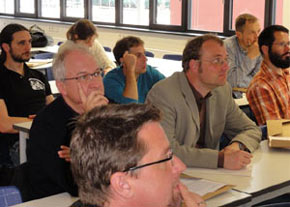

At a workshop in Leipzig, German and BIOTA-FAPESP scientists discuss challenges to research on biodiversity and the importance of international studies (photo: M.Meletti)
At a workshop in Leipzig, German and BIOTA-FAPESP scientists discuss challenges to research on biodiversity and the importance of international studies
At a workshop in Leipzig, German and BIOTA-FAPESP scientists discuss challenges to research on biodiversity and the importance of international studies

At a workshop in Leipzig, German and BIOTA-FAPESP scientists discuss challenges to research on biodiversity and the importance of international studies (photo: M.Meletti)
By Maria da Graça Mascarenhas, in Leipzig
Agência FAPESP – “Brazil and Germany have a very fruitful cultural and scientific history. Martius [Carl Philipp von Martius (1794-1868)] and Humboldt [Alexander von Humboldt (1769-1859)] began an international cooperative process with Brazil in the area of biodiversity that has recently been taken up again, and we intend to move forward with it.”
This affirmation came from professor Matthias Schwarz, vice rector of Germany’s University of Leipzig, at the opening of the Opportunities and Challenges of research Cooperations Brazil-Germany workshop which proceeded the opening ceremony of the exposition Brazilian Nature: Mystery and Destiny, on April 29th at the university. The exposition will be open to the public until July 15th.
“There are questions that are challenges to humanity, such as mitigation of climate change, preservation of biodiversity and alternative energy sources. All can be dealt with and taken on through collaboration of the international science community, in an interdisciplinary manner,” said Schwartz.
In this sense, an important focus at the University of Leipzig is internationalization and development of collaborative research on a global level. “Our university’s strategy is to create networks of international scientists to take on international challenges in science. This presupposes the involvement of students and creation of a new generation of researchers that is open, creative, and able to work in this international research environment,” he said.
Von Martius’ Flora Brasiliensis was published In the city of Leipzig. The University of Leipzig is Germany’s second oldest, with 600 years and around 30,000 students. In the specific case of biodiversity, researchers from the university connected to the Institute of Geography and Biology have participated in collaborative research with Brazilian researchers with funding from the German Ministry of Education and Research for some years.
The project, “Landscape Dynamics and use of the land inside the Atlantic Rainforest of Rio de Janeiro” is being developed through a partnership between researchers at Empresa Brasileira de Pesquisa Agropecuária (Embrapa) [The Brazilian Farming and Cattleraising Research Company], the Universidade Federal do Rio de Janeiro (UFRJ), the Universidade Estadual do Rio de Janeiro (UERJ) and the Serra dos Órgãos National Park, through the Chico Mendes Institute for the Conservation of Biodiversity, and organ of the Ministry of the Environment.
The general coordinator of the project at the University of Leipzig is geographer Jürgen Heinrich and its scientific coordinator is biologist Dietmar Sattler, both from the Institute of Geography and Biology. Sattler was responsible for the invitation to present the Brazilian Nature exposition at the university and for realization of the workshop.
“I saw offering the university to host the exposition as an opportunity to promote Brazilian biodiversity research in Germany and the possibility to start up a partnership with researchers from the BIOTA-FAPESP Program,” Sattler told Agência FAPESP.
“We work with the Atlantic Rain Forest in Rio de Janeiro and could increase the reach of research. After all, nature isn’t restricted by administrative boundaries,” he pointed out.
The same opinion is held by Carlos Alfredo Joly, member of BIOTA-FAPESP’s coordination team who participated in the workshop speaking about the program and presenting some results from his Thematic Project. The project studied the Atlantic Rain Forest in varying altitudes from 0 to 1,000 meters above sea level, observing forest composition, carbon and nitrogen stock and the carbon and water cycles between the forest and the atmosphere.
“Germany could be an important partner in collaborative and exchange projects inside BIOTA because there is already a strong cooperative tradition in botany, zoology and ecology, and there is interest on the parts of the research institutions (universities and institutes) and funding agencies,” said the also-director of the Department of Thematic Policies and Programs (DPPT) in the Ministry of Science and Technology (MCT)’s Secretariat of Research and Development Policies and Programs.
According to Joly, the group at the University of Leipzig that has been working in the Atlantic Rain Forest mostly in Rio de Janeiro could be participating in BIOTA-FAPESP projects that work with modified landscapes or conserved areas throughout the Atlantic Rain Forest region.
“Some results obtained by the Rio de Janeiro group could be compared with those we have from São Paulo, greatly adding to the studies and knowledge,” he affirmed.
Republish
The Agency FAPESP licenses news via Creative Commons (CC-BY-NC-ND) so that they can be republished free of charge and in a simple way by other digital or printed vehicles. Agência FAPESP must be credited as the source of the content being republished and the name of the reporter (if any) must be attributed. Using the HMTL button below allows compliance with these rules, detailed in Digital Republishing Policy FAPESP.





